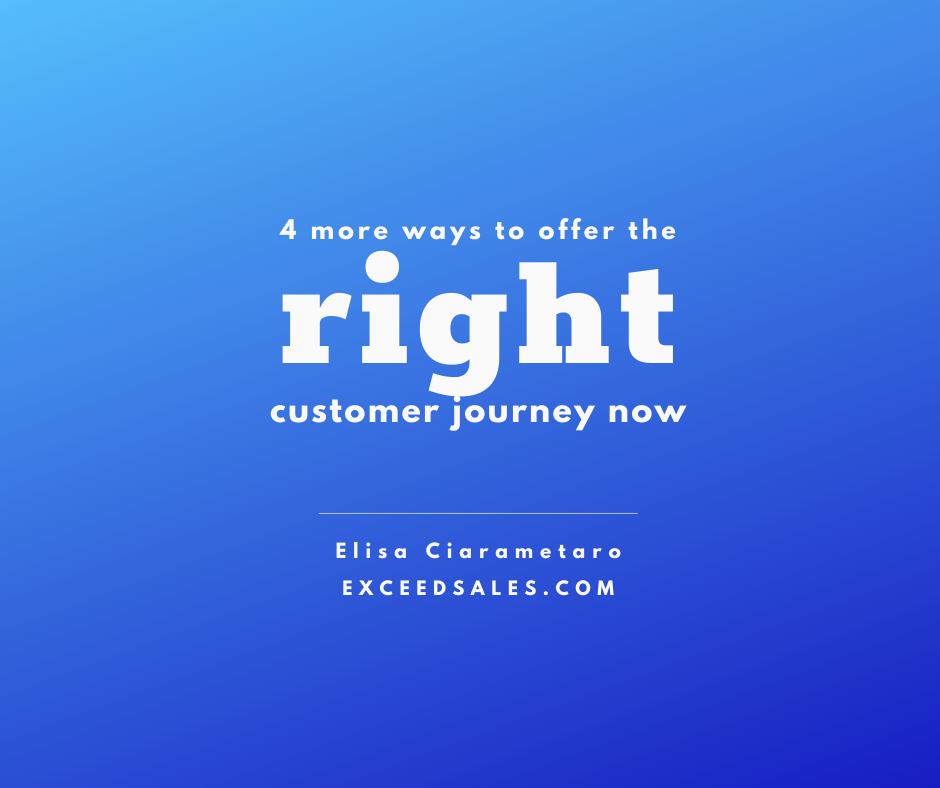Everyone wants to treat customers and prospects right. Back in March I promised you additional suggestions to keep your customers close and prospects closer. Here are my additional observations to make the customer journey and experience pleasant, meaningful and productive.
Customer journey advice is certainly plentiful. But in my experience, most attempts to practice and adhere to it are inconsistent at best. At worst, it falls on deaf ears.
Your customer journey needs careful management, especially now.
Here are some additional suggestions from my observations that I hope will help and guide you.
1. Limit follow-up messaging to one sender and one email at a time.
Make sure processes align with the prospect and customer needs and wants.
Businesses are automating processes to increase employee efficiency and productivity, which of course is a great thing. But first they must take into account the buyer journey and customer experience when developing the process before automating the process.
Limit the amount of automatic email responses you send to a prospect or customer inquiry or problem. While you want to keep the customer or prospect informed, tell them how and who is helping them. Don’t send multiple emails from different representatives with different messages to prospects and customers. They are confusing and annoying to the prospect or customer and delay the resolution process.
2. Ask, discover and listen.
Your goal is to satisfy the customer. If you are in sales, it’s the same goal, whether you have a quota and are asked to provide information, schedule a demo, or set a meeting. If you are in customer service it doesn’t matter if you are tasked with answering a question or solving a problem. Any company or employee representative should be equipped to help the prospect or customer.
Ask the right questions so you can guide the buyer’s journey and provide a satisfying experience. Simple, concise, short and open ended questions are best. Now is not the time for a pitch. It’s time to discover so a diagnosis leads to a satisfactory outcome for the customer. How can I help you? And when do you need it by?
Listen to what you are being told by the prospect or customer. People usually do not listen to others when they are talking because they are thinking about their response. Be quiet, listen and comprehend. Repeat what you heard from them back to them. This ensures a mutually agreed up understanding between both parties. It helps avoid miscommunication, which can result in a delay to the prospect or customer resolution.
3. Resolve the issue.
Find out what the prospect or customer needs and get it to them. It sounds simple! However, the path to a resolution can be complicated, so everyone involved needs to see it through.
The person who first responds to the prospect or customer may not be the person who has the answer in the end. Still, it is that first person’s responsibility to interface with the customer or prospect to see that their inquiry is answered or problem solved.
It may be that the first person has to hand off the prospect to reach the necessary resolution. Another representative may be better able to answer an inquiry or solve the problem. But if this is the case, it is imperative that a three-way introduction or handoff occurs between the inquirer, their first point of contact in the company, and the person taking over responsibility to resolve the problem or inquiry.
4. Be empathetic and timely.
Be timely. Your 24-hour or 48-hour automated response time may not be right for each situation.
A good customer journey depends on those who care about the customer’s or prospect’s problems, challenges, and struggles, and are dedicated to making their business life better with creative and innovative resolutions.
If you truly understand their inquiry or problem you will realize one size doesn’t fit all. Set the timing to respond accordingly to increase customer satisfaction.
I hope these insights are helpful. Please feel free to reach out if we can help resolve an issue for you.

